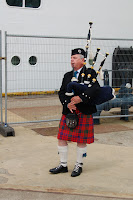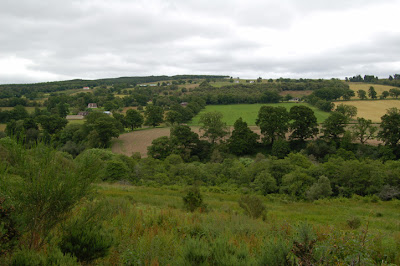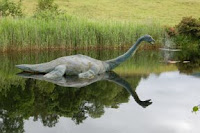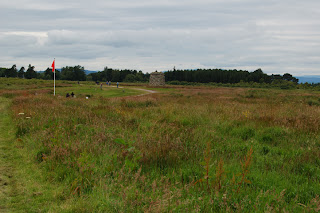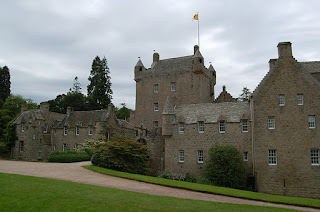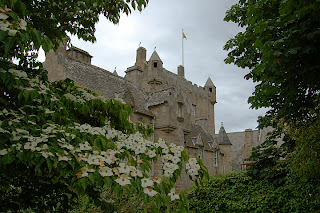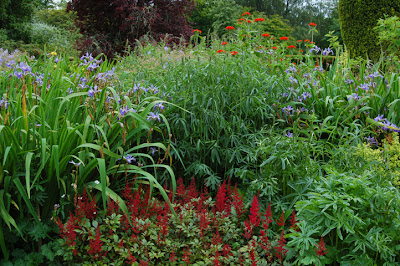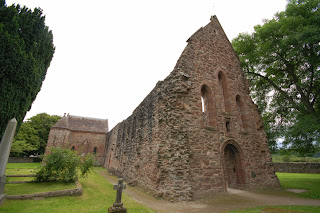Thursday, July 12, 2007 – Inverness (Invergordon), Scotland
We docked in Invergordon bright and early, and upon arrival we were treated to the glorious sound of bagpipers serenading us as we went ashore.
I enjoyed all of the ports we visited on this trip, but if I had to single out just one as a favorite, it would be this one.
There were many things we wanted to see in Inverness, so we hired a private tour ahead of time from J.A. Johnstone Chauffeur Drive. The owner was an absolute pleasure to deal with, and I highly recommend him. Our driver/guide for the day was Ian (Our second Ian in a row!) and he was wonderful.
As soon as we stepped off the ship in Invergordon, Ian was waiting to whisk us away to Inverness. The plan: see all of the big attractions, while staying one step ahead of the tour buses in order to avoid the crowds!
NOTE: One of the great things about having a driver with a car, as opposed to a larger tour bus, is that many of the country roads in Inverness are picturesque but n-a-r-r-o-w—too narrow for a big bus to maneuver through, so we got to see some gorgeous backroads farmland, without hitting any traffic. In addition to the sheep and cattle, we saw some beautiful red deer grazing in the lush valleys of Inverness. Ian also pointed out some teenage boys working their lucrative summer jobs: picking out the wild oats that grow in the barley fields. The oats have to be weeded out before the barley can be harvested, and the boys are paid by how many bushels of oats they can tear out by the end of the day. We also saw some men playing “shinty”, a game similar to hurling.
Ian taught us a few things about Scottish vocabulary during the drive from Invergordon to Inverness. We knew that “loch” was the Scottish word for lake, but he also told us that “firth” meant “an inlet of water”, and that when you see a place name that has the prefix “Kil” in it (e.g. Kiltarlity), that means a monk lived there.
First up: we made a brief visit to the Loch Ness Visitor’s Center, to have a closer look at Nessie.
We also drove through a great little town named Beauly that was dotted with shops all along the main street, and we decided to stop there for some shopping on the way back to the ship later.
Along the way, Ian mentioned that although this area is commonly referred to as “The Black Isle” it is not really an island at all, but a peninsula. We thoroughly enjoyed the stretches of driving in between the tourist sites, because the natural, unspoiled beauty of Inverness is an attraction in and of itself.
Our next stop was Urquhart Castle, a medieval castle that sits alongside the waters of Loch Ness, and was the literary setting for Shakespeare’s Macbeth. The castle itself is worth the trip, but the vistas of the loch from that vantage point are also not to be missed.
The gift shop was large and very crowded (a tour bus arrived and everybody swarmed the place) but it’s a good place to pick up some souvenirs—lots of choices, including stuffed toys, books, jewelry, and housewares. My daughters picked up a stuffed Nessie doll, a Scottish wildlife calendar, and I got a few Christmas ornaments before heading out. (We also used the restrooms, which were very clean and handicapped accessible.)
Then we drove along the country roads again, stopping at some quiet spots to take a few photos and plead with Nessie to show herself, just once. (Alas, she was too shy, and didn’t accommodate us this time. Maybe you’ll have better luck?)
Our next stop was Culloden Battlefield. I confess, I did not know much at all about Scottish history before this trip, or the level of violence and bloodshed that occurred here at Culloden all those years ago. Ian spoke of Culloden with a reverance in his voice, and told us to take note of the utter stillness as we walked out onto the battlefield site. “You don’t hear a sound out there,” he told us before we went in. “It’s like even the crickets know it’s hallowed ground, and keep silent.”
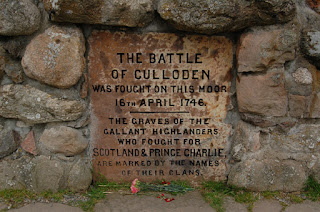
Whatever you do, don’t just rush out onto the battlefield; start your visit to Culloden by watching the short film that describes the history behind the massacre that occurred there. Note for those with young children: the film was not overly graphic or scary, and our 7-year-old was fine with it.
After the film, a young boy came into the screening room dressed in traditional Highlander clothes and played a plaintive song on the bagpipes. Then, another man dressed in character as a French Regiment soldier gave a “living history” presentation. He did a great job, and was very engaging as he demonstrated the various battle weapons that were used during the fighting at Culloden in 1742. He showed how the Highlanders’ weapons were indeed fearsome (shields, swords, knives, and brave fighting techniques), but were no match for the advanced weaponry of the British soldiers and the French allies (canons, rifles, buckshot, and a take-no-prisoners/show no mercy military directive). It was then time to go out to the battlefield.
Culloden Battlefield is vast and beautiful and eerie. There are stone markers throughout the field that bear the names of the Highlander clans that suffered fatalities that day. The site definitely has a palpable “presence” about it that is stirring, and one that I will always remember.
NOTE: The City Sightseeing bus company that runs those Hop On/Hop Off buses had a route in Inverness that also includes a Culloden Loop Tour from May 26th-Sept. 30th. If you’d like to tour Inverness on your own, you might want to check it out.
Next was Cawdor Castle, a fine example of medieval architecture that has been beautifully preserved. The current owner, The Dowager Countess Cawdor, lives in the castle from October through April, but has it open to visitors from May to September. Ian spotted the Countess herself driving in as we were leaving, and mentioned that she stops in often, even during touring season.
The castle was in great condition, and it was interesting touring the bedrooms and seeing the traditional furnishings—antique furniture, artwork, fine tapestries—alongside more modern-day touches. For example, a sidetable in one of the guestrooms had a stack of old, leather-bound books…and a hardcover copy of Dan Brown’s The DaVinci Code nestled among them.
Make sure you stop in the dungeon (duck your head—low entryway) and see the famous Willow Tree. As the legend goes, the battle-weary Thane of Cawdor returned to his homeland a wealthy man, and decided that he wanted to build himself a grand castle to live in. He had his donkey with him for the journey, and declared that wherever his donkey lay down and rest for the night, that was the spot where he would build his castle. That evening, the donkey chose a shady spot under a willow tree, and that is precisely where the Thane of Cawdor had his castle built. Rather than cut the tree down, they built around it, and you can still see what remains of it to this day.
We were pretty hungry after all of that touring, so we stopped at the Cawdor Café restaurant for a bite to eat. The choices were a bit limited (not much for picky eaters here) but the food was very good. The younger kids made due with some fruit salad and a cheese platter, while Rich and I had toasted panini sandwiches and sampled some local beer from Inverness’ own Black Isle Brewery . Rich had a Blonde Ale and I had the Red Kite Ale; both were excellent.
After lunch, we explored the grounds a bit. The kids enjoyed the walled garden maze, but the star attraction was the breathtaking Flower Garden. It was the most lovely, colorful, fragrant garden I have ever had the pleasure of visiting. Pictures can’t possibly do it justice. There are paths that wind through the garden, leading to benches where you can sit and take in the natural beauty around you. There’s also a door on the right side of the garden that leads out to miles of nature trails through the woods.
It was time to head over to Beauly for a bit of shopping before going back to the ship. I told Ian that I was looking for some authentic local crafts, not the usual touristy stuff, so he dropped me and the girls off at House of Beauly (formerly known as Made in Scotland) and took Rich over to a nearby Priory to take some pictures there while we shopped.
There was a fine selection of woolen items and specialty crafts from local artisans there, but the section that drew my attention was the Food area. There was a wonderful selection of Scottish cookies, jams (some flavored with single malt whisky), chocolates, whiskey cake, spirits, honey, and—oh my gosh, can it be?—Haggis in a can.
And yes, I bought some.
After a few minutes, we met up with Rich and Ian again, and made our way back to Invergordon. As we drove over the bridge, Ian pointed out some seals sunning themselves on the rocks during low tide (they raise their heads and tails up in the air as they bask, forming a wide U-shape).
We made it back to the ship just in time to enjoy a terrific Scottish Folkloric show at 5pm (don’t miss it!) featuring local musicians, singers and dancers. They wore traditional dress and put on a great show for the large and enthusiastic crowd in the Princess Theater. It was the perfect way to end our magical day in Inverness/Invergordon.
After dinner, we went to the late show to see Frank Delana, a comedian who has appeared on David Letterman and HBO. (I liked him immediately because, like me, he hails from Brooklyn, New York.) He was very funny and got a lot of laughs.
Coming soon: Beware of ladders and black cats…it’s Friday the 13th in Edinburgh!

